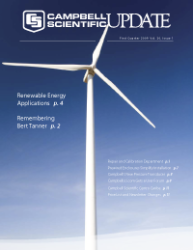Renewable resources account for only a small percentage of the energy the world consumes. The drive to reduce our dependence on fossil fuels and produce energy from more environmentally friendly sources has led to an increasing number of projects to develop these resources.
The use of our dataloggers in renewable-energy applications is nothing new, but the recent surge of interest in renewable resources has triggered a corresponding increase in the need for quality measurements.
Because of this increased activity, we recently created a new application engineering group dedicated to supporting those who are developing or conducting research on these critical renewable resources. Our extensive experience combined with the versatility of our dataloggers can prove valuable to those who need quality measurements for their projects.
When the success of multimillion-dollar wind or solar farms can be determined by a difference of less than one percent between measured and actual values of wind speed or sunlight, some have found out the hard way that quality measurements matter. The need for making quality measurements over long periods of time, in harsh, remote sites (where renewable systems are often located), is what has attracted people to our dataloggers for years.
Below we list typical monitoring applications in four of the most common renewable-energy areas: wind, solar, hydropower, and geothermal.
Wind
Our systems are used in every stage of wind-power operations.
- Wind-assessment systems provide data to determine the suitability of sites for wind power and the best wind turbine to use.
- Turbine-performance systems monitor power generated and available wind to help verify manufacturers’ turbine specifications.
- Wind-forecasting stations placed strategically provide local meteorological data that can be combined with regional weather patterns to predict future wind and forecast power generation.
Solar
Campbell Scientific dataloggers are used in all types of solar energy applications, including photovoltaic, solar thermal, and concentrated solar power.
- Site-assessment systems quantify a site’s suitability for solar energy production.
- System-performance packages correlate incoming solar radiation with DC/AC output for manufacturer-specification validation and power-production maximization.
- Comprehensive diagnostic kits pinpoint system failures, provide alarm capabilities, and collect valuable data for preventive maintenance.
Hydropower
Dams require a more diverse set of measurements.
- Reservoir level-monitoring systems above the dam provide information for operating the power plant and maintaining the dam.
- Equipment-performance systems monitor operational factors, such as RPMs on turbines, and can provide condition-based alarms.
- Water-quality systems monitor parameters such as temperature and turbidity to help minimize the impact on fish and other wildlife.
- Structural-monitoring systems keep an eye on bore holes and cracks to help identify problems with dams.
Geothermal
Geothermal applications typically involve measuring water temperature, level, and flow.
- Monitoring systems at observation wells define the flow of groundwater and the hydraulic effects on the surrounding area—helping to determine a site’s suitability for geothermal projects or to plan well spacing.
- Temperature-profiling systems provide data on temperature gradients in well casings.
- Monitoring systems track time/temperature data, water levels, and water quality parameters, providing valuable decision-making data.
We look forward to providing key components that help develop renewable resources. Our new group will be actively creating resources to facilitate the use of measurement and control systems in this area.

